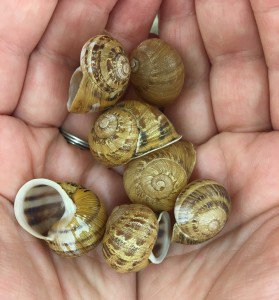Did learning the difference between the lifestyle of the freshwater vs. saltwater mussels whet your appetite? Are you curious whose cousin you are consuming when slurping scallops or opening oysters? Do you catch yourself wondering at night if sea slugs are really related to land slugs? Is your superpower talking to octopuses and you want to know what other animals you may be able to communicate with? We have got you covered.
This time, we are going to discuss the relationships between all these molluscs, so you can learn just how distinct these organisms really are. You will finally be able to join the club* of polite pedantic people standing with on the borderlines between clades reminding anyone who will listen that these organisms are distinct! Among our allies are those who pipe up whenever someone calls a spider monkey an ape and folks who visibly wince whenever anyone implies that a spider is a bug. This is the kind of knowledge you can brag about. You’ll never need something to talk about on a date again. Those long thanksgiving dinners with extended family will be a breeze! Shells are easy to carry around as props so you can always be prepared!
*there is no club
ARE YOU READY TO READ?!
(Those of you who already know the difference are also invited to read on but are given explicit permission to feel slightly smug while doing it. It’s a win either way.)
Molluscs
The shelled and spineless wonders we call Molluscs are separated into classes, only three of which include names of animals most people will recognize…
- In the first corner we have the Cephalopods. These include those fancy and clever tentacled party animals known as squids, octopuses, and ammonites.
![Octopus marginatus by Jens Petersen (Own work) [GFDL (http://www.gnu.org/copyleft/fdl.html), CC-BY-SA-3.0 (http://creativecommons.org/licenses/by-sa/3.0/) or CC BY 2.5 (http://creativecommons.org/licenses/by/2.5)], via Wikimedia Commons](https://u.osu.edu/biomuseum/files/2016/09/800px-Octopus_marginatus2-rwd7uq-300x225.jpg)
Octopus marginatus by Jens Petersen, CC-BY-SA-3.0 via Wikimedia Commons
Squid are somewhat terrifying predatory cephalopods that people like to eat and call Calamari. A certain group of well hid squid make a bid to be one of the largest living organisms on our little blue planet.
- In our second corner sit Gastropods (our mucus coated friends we know as snails, slugs, and the other fancy-shelled non-hinged marine groups like conchs)
![By Robin Agarwal (Own work) [CC BY-SA 4.0 (http://creativecommons.org/licenses/by-sa/4.0)], via Wikimedia Commons](https://u.osu.edu/biomuseum/files/2016/09/Phidiana_lynceus_from_Port_Canaveral_Florida_01-16jiub0-300x258.jpg)
By Robin Agarwal CC BY-SA 4.0, via Wikimedia Commons
Nudbranchs, also known as Sea Slugs, are not slugs at all and are actually sea snails that have lost their visible shell. They’re often tiny and brightly colored to show other denizens of the local reef that they’re dangerous. They have an incredible habit of stealing functional stinging cells from their prey, storing them in their bodies, and firing them at predators!
- And, finally, the group we’re REALLY looking at today are found in the third corner and are known as Bivalves (the headless and hinged filter-feeding fellows including scallops, clams, and mussels).
Bivalves
The bivalves are divided up into a few groups, only three of which we are concerned with at the moment.
These groups include the
- Heterodonta
These are the happy-as-an-invasive-species clam that invaded our rivers and is not yet to be forgiven. They’re called corbicula or Asian Clams and are so small that they’re really not worth eating.

This is Arctica icelandica, the species of clam used for the ever famous New England Clam Chowder.
They’re not clammy at all. They’re actually surprisingly dry. They don’t have faces so when they tell jokes it’s completely deadpan.
- Palaeoheterondonta
If you’re wondering where our beloved freshwater mussels are found, they’re here in a group known as the Unionids. They’re rather special and so get to hang out in their very own group as they’re the only parasitic freshwater bivalves out there, and stand relatively alone. (If you want to get obscure, they’re actually joined in the palaeoheterodonta by an almost-extinct group known as the Trigoniida.)
and, last but not least, very edible group known as the
- Pteriomorphia
It is in this last group that you can find the ever delicious scallops
the inedible-looking oysters, and the aforementioned saltwater mussels.
Unlike popular seafood fishes, the array of molluscan meats we consume are mostly sustainable. If you click any of the linked names above, you will be redirected to the Monterey Bay Aquarium’s Seafood Watch Website and their sustainability guidelines for those particular creatures.
If you have any interest whatsoever in protecting our oceans and preserving biodiversity, PLEASE download a printable seafood watch guide for your state, or download the wonderful app they’ve created to check seafood on the go. I can not encourage you strongly enough to always ask at any restaurant or grocery from where they get their seafood, and reject ordering any that weren’t harvested in a sustainable manner.
PS. Always check for shrimp, as it is notoriously unsustainable. Saltwater mussels, on the opposite side of the invertebrate sustainability spectrum, are one of the best seafoods possible.
*Bieler, Carter, & Coan 2010 Classification of Bivalve families (113-133), in: Bouchet & Rocroi 2010, Nomenclator of Bivalve Families. Malacologia 52(2): 1-184
About The Author: Sara Klips is the Mussel Fairy. She graduated from The Ohio State University with a degree in zoology and tries not to stress out too much when it comes to planetary preservation.





